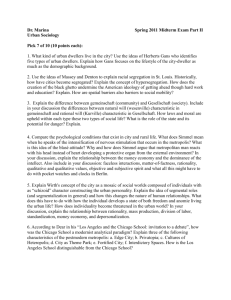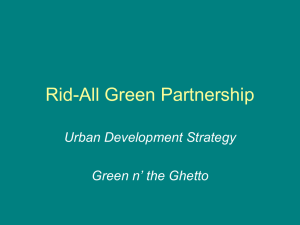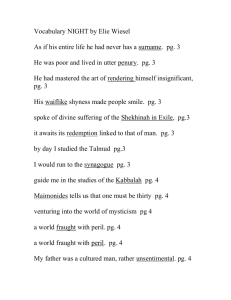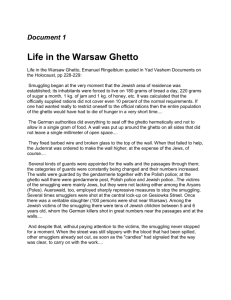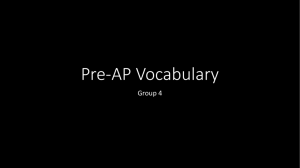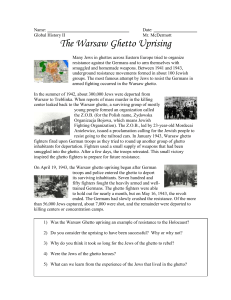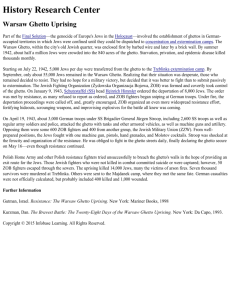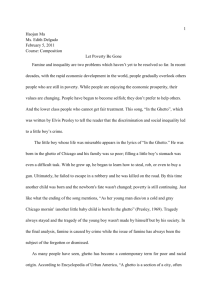JUSTICE Lecture 23 – Justice & the Ghetto Poor
advertisement
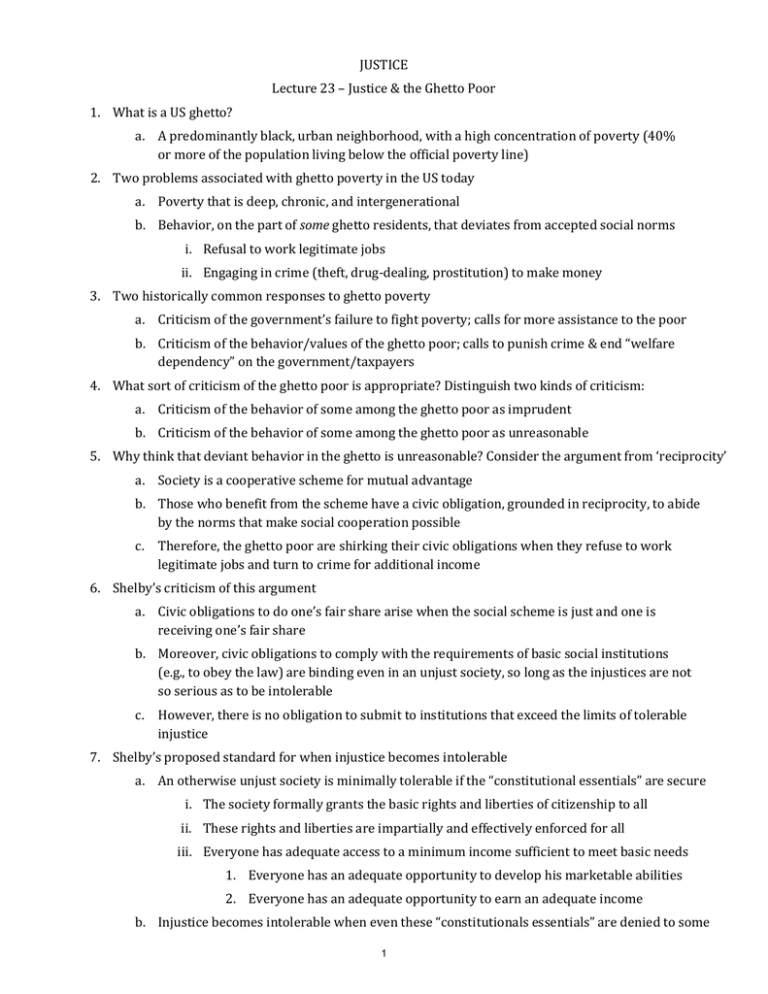
JUSTICE 1. What is a US ghetto? Lecture 23 – Justice & the Ghetto Poor a. A predominantly black, urban neighborhood, with a high concentration of poverty (40% or more of the population living below the official poverty line) 2. Two problems associated with ghetto poverty in the US today a. Poverty that is deep, chronic, and intergenerational b. Behavior, on the part of some ghetto residents, that deviates from accepted social norms i. Refusal to work legitimate jobs ii. Engaging in crime (theft, drug-dealing, prostitution) to make money 3. Two historically common responses to ghetto poverty a. Criticism of the government’s failure to fight poverty; calls for more assistance to the poor b. Criticism of the behavior/values of the ghetto poor; calls to punish crime & end “welfare dependency” on the government/taxpayers 4. What sort of criticism of the ghetto poor is appropriate? Distinguish two kinds of criticism: a. Criticism of the behavior of some among the ghetto poor as imprudent b. Criticism of the behavior of some among the ghetto poor as unreasonable 5. Why think that deviant behavior in the ghetto is unreasonable? Consider the argument from ‘reciprocity’ a. Society is a cooperative scheme for mutual advantage b. Those who benefit from the scheme have a civic obligation, grounded in reciprocity, to abide by the norms that make social cooperation possible c. Therefore, the ghetto poor are shirking their civic obligations when they refuse to work legitimate jobs and turn to crime for additional income 6. Shelby’s criticism of this argument a. Civic obligations to do one’s fair share arise when the social scheme is just and one is receiving one’s fair share b. Moreover, civic obligations to comply with the requirements of basic social institutions (e.g., to obey the law) are binding even in an unjust society, so long as the injustices are not so serious as to be intolerable c. However, there is no obligation to submit to institutions that exceed the limits of tolerable injustice 7. Shelby’s proposed standard for when injustice becomes intolerable a. An otherwise unjust society is minimally tolerable if the “constitutional essentials” are secure i. The society formally grants the basic rights and liberties of citizenship to all ii. These rights and liberties are impartially and effectively enforced for all iii. Everyone has adequate access to a minimum income sufficient to meet basic needs 1. Everyone has an adequate opportunity to develop his marketable abilities 2. Everyone has an adequate opportunity to earn an adequate income b. Injustice becomes intolerable when even these “constitutionals essentials” are denied to some 1 8. Shelby: the constitutional essentials are denied to people who are born into ghetto poverty in the US a. The ghetto poor lack adequate access, through legal means, to a minimum income sufficient to meet basic needs i. The menial service jobs available to the ghetto poor pay wages too low to escape poverty ii. Ghetto schools are substandard; ghetto residents cannot acquire skills to get higherpaying, high-skilled jobs iii. The ghetto poor cannot afford to move to the affluent suburbs where the schools are better; and governments/cities tend to subsidize housing only in poor areas, not in affluent suburbs iv. Welfare payments are not high enough for families to live adequately v. Now that welfare has been replaced with workfare, those who accept welfare benefits are compelled to work at menial jobs for poverty-level wages b. When some among the ghetto poor turn to illegal sources of income, they are routinely treated more severely by the criminal justice system than other citizens who commit similar crimes i. There is class bias in the punishments attached to similar crimes (e.g., punishment attached to selling powdered cocaine vs. crack cocaine) ii. There is racial discrimination in arrest, prosecution, and sentencing for property crimes and drug crimes (e.g., rates of illegal drug use are similar among blacks and whites and yet blacks are sentenced to prison for illegal drug use at several times the rate of whites) c. Partly as a result of these violations of “formal justice”, there are significant racial disparities in the suspension of basic rights i. Black men are ~6% of the general population but account for ~30% of the prison population ii. Felony disenfranchisement for blacks is three times the national average; one in thirteen blacks are barred from voting, one in eight black men 9. Shelby’s conclusions a. The basic structure of US society exceeds tolerable injustice in how it treats the ghetto poor b. Therefore, when some among the ghetto poor refuse to work menial jobs or turn to crime for income, they do not thereby violate any civic obligations grounded in reciprocity c. This does not mean that no criticism of the behavior of the ghetto poor is appropriate i. Like everyone else, the ghetto poor have natural (non-civic) duties towards other persons ii. Like everyone else, the ghetto poor have a duty to support the creation of more thoroughly just institutions iii. These duties are incompatible with some criminal attitudes and behaviors d. But it is a mistake to suppose that the ghetto poor should avoid deviant behavior because they have a civic obligation of reciprocity to play by the rules like everyone else; submitting to the demands of unjust institutions is incompatible with the duty to respect oneself 2 MIT OpenCourseWare http://ocw.mit.edu 24.04J / 17.01J Justice Spring 2012 For information about citing these materials or our Terms of Use, visit: http://ocw.mit.edu/terms.
